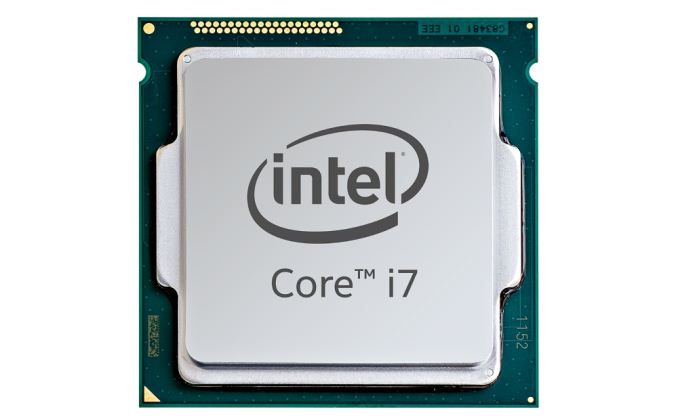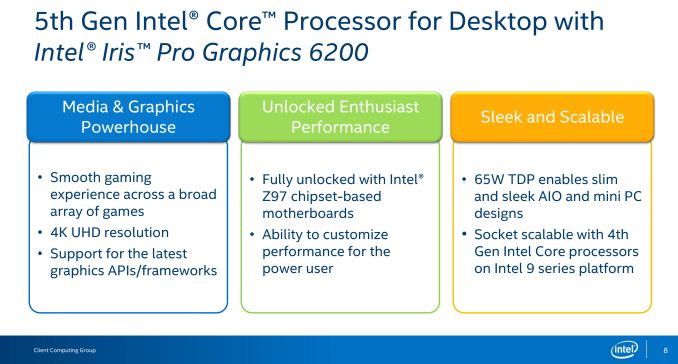The Intel Broadwell Desktop Review: Core i7-5775C and Core i5-5675C Tested (Part 1)
by Ian Cutress on June 2, 2015 7:45 AM ESTBroadwell-DT: Initial Thoughts
The new Broadwell desktop processors are somewhat out of sync with our regular expectations from Intel. Due to issues surrounding the 14nm node, as well as the cost, the whole Broadwell line from tablet to table-top has come out slower and more staggered than any Intel release in recent memory. As a result, the initial launch from Intel today is a pair of 65W desktop socketed models backed up with three 65W soldered down models whose true heritage is a chip primarily designed for large laptops and all-in-one devices.
Normally we would expect a range of desktop models from 35W up to 88W or higher, but socketed Broadwell-DT today only exhibits two units at 65W. This immediately puts a slight damper on those expecting to upgrade from Haswell’s high-end, or those wanting to go from something like a Pentium G3258 on Haswell to Broadwell’s top SKU. As a result, we have to keep our expectations in check – 65W should on paper perform nearly as well as an 88W part would, except it would be reduced by several hundred MHz. Meanwhile as these processors are also fully-unlocked and overclockable, we're left to ponder whether or not the stock frequencies actually matter in that case.
Due to the differential tangent at play, these processors also exhibit Intel’s best integrated graphics package, Iris Pro (GT3e), previously reserved only for soldered down/laptop/mini-PC orientations. This graphics package comes with largest number of execution units available from Intel, 48, alongside 128MB of eDRAM that acts almost like an L4 cache. This helps alleviate memory bandwidth pressure by providing a large(ish) pool near the CPU but with lower latency and much greater bandwidth than main memory. The eDRAM has the greatest effect in graphics, but we also saw some moderate increases in our non-3D regular benchmark suite.
The benefit of the graphics package, Iris Pro 6200, means that Broadwell-DT takes the crown as the fastest socketed graphics available. Our testing showed that the even the second-tier socketed SKU, the i5-5675C, outgunned the previous title holder, AMD’s A10-7870K. Despite having the i7-5775C in to test, due to time and firmware issues, we were unable to run the numbers on the integrated graphics but will do so in a later piece.
The key element to Broadwell-DT is not to consider it a natural successor to Haswell. It doesn't so much replace Haswell-K at this time, so much as it occupies a space Intel has left neglected since the launch of Haswell – the ultimate Intel integrated graphics solution. For users on integrated graphics, where money is no object, Intel now offers you the option to combine the regular CPU performance associated with Intel and a GPU that has the added performance benefits of on-chip, high-bandwidth eDRAM. The only question is whether that combined performance is worth the potential cost, and some would say no, pointing at a combined APU + GPU solution for equivalent or better gaming performance for the same price.
Pricing for the i5-5675C is listed as $276, slightly higher than the price of the i5-4690K which is at $236 on Amazon (reduced from $265). The i7-5775C is a bit higher at $366, also a margin higher than the i7-4790K which is $339 (reduced from $380). This makes Broadwell a tough sell right now in most circumstances unless you are absolutely limited to integrated graphics and want the best solution possible in a configurable PC. Given that Intel has also mentioned Skylake in their recent Computex keynote, it implements an abnormal situation that Intel has never been in with a new platform being talked about in the same breath. We have been told that these parts exist because users wanted them, and it has been interesting to see just how the added eDRAM changes the performance with discrete graphics in the mix.












196 Comments
View All Comments
iTon - Saturday, June 6, 2015 - link
i've think AMD products best when used Mantle API. it can boost up to 30% than DirectX API. Otherwise 10% parts of AMD APU had TrueAudio DSP Processor. so it is not 100% CPU and GPUOxford Guy - Saturday, June 6, 2015 - link
Six APUs and not one FX chip in the charts.LAME
Oxford Guy - Saturday, June 6, 2015 - link
Heaven forbid someone might see that you can get a better Cinebench multithread score from a $100 8320E than from a pricey Intel...Oxford Guy - Saturday, June 6, 2015 - link
8320E with 1600 8-8-8-24 RAM at 1585 due to FSB, Cinebench 15 multithreadone core per module, 4.28 GHz, 399
one core per module, 5.02 GHz, 467
3.33 GHz, 540
one module disabled, 5 GHz, 590
3.8 GHz, 608
Intel i7-3770, 3.4 GHz, 662
4.17 GHz, 664
4.2 GHz, 675
4.28 GHz, 683
4.41 GHz, 703
4.56 GHz, 724
4.68 GHz, 743
4.78 GHz, 765
Intel 4770K at 4.4 GHz, 822
Clearly, an overclocked Intel will beat this chip in this test but if you have an Intel that can't be overclocked that may be a different story, depending on the stock clockspeed of the chip. Also, Cinebench is, as far as I know, a test that favors Intel since it relies heavily on FPU. None of the APUs are close to FX's performance so the lack of even one 8 thread FX in the charts is not good.
The single thread performance of FX is particularly weak but it can be improved quite a bit by setting the chip to 1 core per module because high clocks can be achieved with much less heat than when the full 8 threads are enabled. The downside is that multithread performance suffers (in tests like Cinebench that can use all 8 threads... perhaps not so much in programs that max out around 4).
single thread
A10-7850K, 92
4.2 GHz, 99
A10-6800K, 100
4.78 GHz, 111
5 GHz, 118
5.02 GHz, (one core per module), 120
5.21 GHz (only one module enabled), 122
5.17 GHz (one core per module), 122
Intel i7 3770, 3.4 GHz, 138
Intel i7 3930K, 3.3 GHz, 148
Oxford Guy - Saturday, June 6, 2015 - link
highest scoring APU in the multithread test:A10-6800K, 325
sireangelus - Saturday, June 6, 2015 - link
Anand, i'm going to heavly critizice your linux testing method.you go to great lengths to adjust and compensate for turbo modes, but on an ubuntu 11.04 it should completely ignore turbo modes since sandy bridge or does not even know what turbAdvances in the linux kernelo modes are, severely limiting both new intel and amd cpu. Also, the power profile is changed alongside the new intel pstate driver, that greatly improved performance under linux in respect to the past; also, new kernels are optimized for the eDram on the crystal well cpus. I suggest you start moving the whole testing platform to something more current or simply redo tests once a year with an updated kernel. You could use the phoromatic platform to automatize the procedure.
Ramon Zarat - Sunday, June 7, 2015 - link
Please add clock for clock comparison with older Intel CPU! Back to at least Sandy Bridge or even further if possible.ES_Revenge - Sunday, June 7, 2015 - link
So clearly Intel has now topped AMD's one remaining trump card--integrated graphics performance. Of course you're paying over 2x the cost for the privilege. One might argue that you're still getting a much better CPU at the same time, which is true, but most people just look at the absolute cost and the fact that the A10 is not all that bad a CPU.I think this becomes *much* more interesting if/when Intel starts producing *i3* CPUs with Iris Pro. Then it's really game over for AMD, unless Zen is something spectacular to allow them to catch up (or even get close) in CPU performance. AMD could also easily up the SPs in their APUs to something like ~1024 which would give them R7 265/PS4/GTX 750 Ti -class performance. The only problem is AMD hits another hitch there as they don't have the thermal/power envelope to do so given A10s can already throttle the CPU side when the GPU is in heavy use, in order to stay within TDP limits. AMD's lack of power and thermal efficiency with their GPUs (as competent as they are otherwise) also poses a serious problem in putting the same tech on an APU die.
Seems like AMD has to hit a homerun with both Zen for performance and their GPUs for efficiency in the coming year. However from everything we know about Fiji and the fact that the rest of the [GPU] lineup will be re-brands, it doesn't seem likely. Perhaps it's time to quit the CPU business, lol. Either that or release APUs with high-end graphics, boxed with CLC/AIO liquid coolers (or massive air coolers).
0ldman79 - Sunday, June 7, 2015 - link
I know it's a dead socket, but could we AM3+ users request a CPU be thrown in the mix?I keep reading, keep looking, the reviews look impressive, so I check the Anandtech Bench and my 6300 is still faster than the APU's.
In all honesty, that has to hurt AMD. Those of us that went with the "big boy socket" are still faster overall even though the APU has made big leaps in IPC and clock speed.
Fact is we're still out here and the only way to get faster across the board is to jump Intel.
ES_Revenge - Monday, June 8, 2015 - link
Well keep in mind your FX 6300 has two more cores (or one more module) and it has 8MB L3 compared to no L3 at all on the APUs. If they made a "6 core" APU with L3 on Kaveri/Godavari it would be faster.. at least until it starts hitting the TDP limits, lol. This of course is probably why there are no 6 or 8 CPU-core APUs--because they're already having problems with keeping TDP within limits with a 512SP GPU and 4-core CPU.